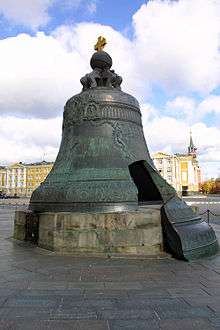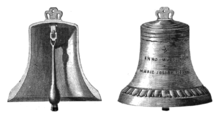Tsar Bell
| Царь–колокол | |
 | |
| Coordinates | 55°45′03″N 37°37′06″E / 55.75083°N 37.61833°ECoordinates: 55°45′03″N 37°37′06″E / 55.75083°N 37.61833°E |
|---|---|
| Location | Moscow, Russia |
| Designer | Ivan Motorin |
| Type | Tower Bell |
| Material | Bronze |
| Width | 6.6 metres (22 ft) |
| Height | 6.14 metres (20.1 ft) |
| Beginning date | 1733 |
| Completion date | 1735 |
The Tsar Bell (Russian: Царь–колокол, Tsar-kolokol), also known as the Tsarsky Kolokol, Tsar Kolokol III, or Royal Bell, is a 6.14-metre (20.1 ft) tall, 6.6-metre (22 ft) diameter bell on display on the grounds of the Moscow Kremlin. The bell was commissioned by Empress Anna Ivanovna, niece of Peter the Great.
It has never been in working order, suspended, or rung.
The present bell is sometimes referred to as Kolokol III (Bell III), because it is the third generation.
General description
The Tsar Bell is located between the Ivan the Great Bell Tower and the Kremlin Wall. Made of bronze, the bell was broken during metal casting and has never been rung. The bell is currently the largest bell in the world,[1] weighing 201,924 kilograms (445,166 lb), with a height of 6.14 metres (20.1 ft) and diameter of 6.6 metres (22 ft), and thickness of up to 61 centimetres (24 in). The broken piece weighs 11,500 kilograms (25,400 lb). [Note 1]
The bell is decorated with relief images of baroque angels, plants, oval medallions with saints, and nearly life-size images of Empress Anna and Tsar Alexey, who was reigning at the time the previous Tsar Bell was cast.
History
The history of Russian bell founding goes back to the 10th century, but in the medieval Russian Orthodox Church, bells were not typically rung to indicate church service, but to announce important ceremonies, celebrations, and as an alarm in case of fire or enemy attack. One of the largest of the early bells was the original Tsar Bell, cast in the 16th century. Completed in 1600, it weighed 18,000 kilograms (40,000 lb) and required 24 men to ring its clapper. Housed in the original wooden Ivan the Great Bell Tower in the Moscow Kremlin, it crashed to the ground in a fire in the mid-17th century and was broken to pieces.
The second Tsar Bell was cast in 1655, using the remnants of the former bell, but on a much larger scale. This bell weighed 100,000 kilograms (220,000 lb), but was again destroyed by fire in 1701.
After becoming Empress, Anna ordered that the pieces be cast into a new bell with its weight increased by another hundred tons, and dispatched the son of Field Marshal Münnich to Paris to solicit technical help from the master craftsmen there. However, a bell of such size was unprecedented, and Münnich was not taken seriously. In 1733, the job was assigned to local foundry masters, Ivan Motorin and his son Mikhail, based on their experience in casting a bronze cannon.
A pit 10 metres (33 ft) deep was dug (near the location of the present bell), with a clay form, and walls reinforced with rammed earth to withstand the pressure of the molten metal. Obtaining the necessary metals proved a challenge, for in addition to the parts of the old bell, an additional 525 kilograms (1,157 lb) of silver and 72 kilograms (159 lb) of gold were added to the mixture. After months of preparation, casting work commenced at the end of November 1734. The first attempt was not successful, and the project was incomplete when Ivan Motorin died in August, 1735. His son Mikhail carried on the work, and the second attempt at casting succeeded on November 25, 1735. Ornaments were added as the bell was cooling while raised above the casting pit through 1737.
However, before the last ornamentation was completed, a major fire broke out at the Kremlin in May 1737. The fire spread to the temporary wooden support structure for the bell, and fearing damage, guards threw cold water on it, causing eleven cracks, and a huge 10,432.6 kilograms (23,000 lb) slab to break off. The fire burned through the wooden supports, and the damaged bell fell back into its casting pit. The Tsar Bell remained in its pit for almost a century. Unsuccessful attempts to raise it were made in 1792 and 1819. Napoleon Bonaparte, during his occupation of Moscow in 1812, considered removing it as a trophy to France, but was unable to do so, due to its size and weight.
It was finally successfully raised in the summer of 1836 by the French architect Auguste de Montferrand and placed on a stone pedestal. The broken slab alone is nearly three times larger than the world's largest bell hung for full circle ringing, the tenor bell at Liverpool Cathedral.
For a time, the bell served as a chapel, with the broken area forming the door.[2]
See also
- Russian Orthodox bell ringing
- The Liberty Bell, a famously damaged colonial American bell cast two decades later
- List of heaviest bells
Notes
Footnotes
- ↑ At 116 metric tons, the Bell of Good Luck in Foquan Temple, Pingdingshan, Henan, China is currently the heaviest functioning bell in the world.
Citations
- ↑ Slobodskoy, Archpriest Seraphim (1996), "Bells and Russian Orthodox Peals", The Law of God, Jordanville, N.Y.: Holy Trinity Monastery, p. 624, ISBN 0-88465-044-8
- ↑ Blair, C. (September 1987). "Review of "The Bells of Russia. History and Technology" by Edward V. Williams". The Antiquaries Journal. 67 (2): 434–435. doi:10.1017/S0003581500025944. ISSN 1758-5309.
...including the remarkable story of Tsar-Kolokol, which is so large that it once contained a chapel...
References
- Klein, Mina. The Kremlin: Citadel of History. MacMillan Publishing Company (1973). ISBN 0-02-750830-7
- Tropkin, Alexander. The Moscow Kremlin: history of Russia's unique monument. Publishing House "Russkaya Zhizn" (1980). ASIN: B0010XM7BQ
External links
| Wikimedia Commons has media related to Tsar Bell. |

